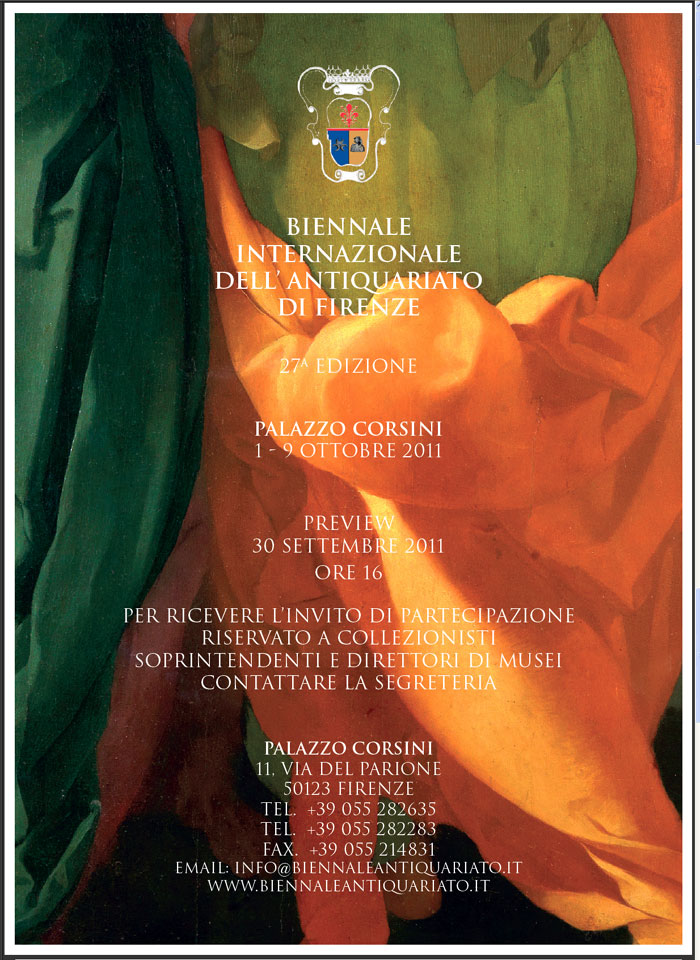Travel and Destinations
XXVII FLORENCE INTERNATIONAL ANTIQUES FAIR October 1-9, 2011 at the Palazzo Corsini
July 26th, 2011 by adminThe 27th Florence International Antiques Fair (aka Florence Biennale) will be hosted this year at the enchanting Palazzo Corsini from October 1st– 9th with a layout masterminded by the Maestro Pier Luigi Pizzi. The Biennale, first started by Mario and Giuseppe Bellini in 1959, is the oldest continuous art and antiques fair in Europe and has become the most important Italian art exhibition in the world.
The home to the bi-yearly Florence Biennale since 1997, the Palazzo Corsini in its subdued Baroque style with an 18th-century flair is truly a unique and greatly admired building in Florence and a sight to see in itself. The residence, which was completed only in 1737, is also the proud home of Florence’s most important and historically significant private gallery, boasting a collection, begun in 1765 by Don Lorenzo Corsini, nephew of Pope Clement XII.
The works of art displayed by antiquarians from all over the world–74 Italian and 14 foreign—are the undisputed stars of the show. The vast variety of the over 3,000 pieces presented at the fair range from paintings to plates and antique books to sculptures.
All the works exhibited at the Biennale will be monitored and authenticated by the Scientific Committee. On September 28th, two Committees, the first appointed by the Florence Exports Office, and the second sent by the Ministry for the Cultural Heritage, will examine the works for which the antiquarians request a free circulation certificate, a document which allows Italian works of art to circulate abroad.
Collateral Events:
The Biennale continues to support Corri la Vita, an association, devoted to the study and prevention of breast cancer presided over by the Marchioness Bona Frescobaldi. On October 1st a charity evening will be held and during the dinner Christie’s will auction works of art donated by exhibitors at the Biennale. The proceeds of the auction will be devolved entirely in favour of the Association.
On October 5th prizes will be awarded to the best painting and sculpture at the Fair. The prizes, amounting to 10,000 Euro each, will be destined to the restoration of a work of art from the public cultural heritage.
On October 6th the “Lorenzo d’oro” prize will be awarded to Piero Angela, for his long and successful career as a director of documentaries.
Press Office:
Sveva Fede, tel. +39 336 693 367, tel. e fax +39 0575 370 368, sveva.fede@libero.it
Press Office for Tuscany:
Anna Pampaloni, tel. +39 055 69 63 65, +39 347 56 20 327, a.pampa@katamail.com
Foreign Press Offices:
Great Britain: Cawdell Douglas, 10-11 Lower John Street, W1R 3PE London (GB), tel. +44 207 439 28 22, fax +44 207 287 54 88, e-mail: press@cawdelldouglas.co.uk
U.S.A.: Jonathan Marder + Company, 24 Fifth Avenue, suite 1530, N.Y. 10011 New York (U.S.A.), tel. +1 646 638 24 79 fax + 1 646 638 25 29, e-mail: m.dattatreya@gsmltd.net
France: Colonnes, Claire Galimard, 16 rue des Saints-Pères, 75007 Paris (France), tel. +33 1 426 070 10, fax +33 1 426 070 07, e-mail: contact@colonnes.com
Info:
Expo Arte e Cultura S.r.l. – Via del Parione 11 – 50123 Firenze – tel. +39 055 282 283 – +39 055 282 635 – Fax +39 055 214 831 – www.biennaleantiquariato.it – info@biennaleantiquariato.it
Short history of the Florence International Antiques Fair
• The Mostra Internazionale dell’Antiquariato was launched in 1959 in the prestigious premises of Palazzo Strozzi. The Fair was the brainchild of Luigi Bellini Sr., designed to attract to Florence the very best in the international antiques world, and it made its name by offering the choicest selection in the collecting and antiques sector. The overwhelming success of the first Fair, and of those which followed, marked the start of a market season increasingly oriented towards the Antiques Fairs. The originality of the idea, accompanied by an astute selection of the antiquarians, transformed the Fair into a cultural and fashionable event that could not be missed, to the extent that the Florentine Fair was visited both by the members of the international jet set and by a crowd avid for curiosities, knowledge and marvels. The international triumph was triggered by the fact that it was held in Florence and was also accompanied for the entire duration by a series of highly attractive cultural and society events.
- Problems in the utilisation of Palazzo Strozzi, where adaptation work was being carried out, meant that in 1977 the antiquarians had to move to Palazzo Giuntini (now the Grand Hotel), after which they returned to the original site up to 1993. In 1987, Guido Bartolozzi took over from the Bellini brothers as the General Secretary.
- When Palazzo Strozzi became definitively unavailable in 1995 the Fair had to be moved to the Palazzo degli Affari, a fine building designed by Spadolini, but entirely unsuitable for an antiquarian fair of the level of the Florentine Biennale. For the following editions of the Fair, the choice fell on Palazzo Corsini sull’Arno, the current premises of the event, where it has been held since 1997.
• In 2001 the Management Committee appointed Giovanni Pratesi, Chairman of the Italian Antiquarians Association, as General Secretary of the Florentine Biennale. This appointment represented a crucial turning-point for the Fair and it was in fact in 2001, with an absolutely innovative design and the inclusion of numerous novelties in the general programme, that the Biennale set off on the path that has led to its being considered today as one of the three most important antiques events in the world.
• To place the Biennale at the level of the most prestigious international Fairs it was decided to promote strict controls on the works displayed, modify the image of the Fair by entrusting the orchestration to the Maestro Pier Luigi Pizzi, who performed an authentic masterpiece of restyling, introducing a new pavilion in the entrance courtyard of the Palazzo, boost promotion by setting up specialised Press Offices in the major cities of the world (Wiesbaden, London, Paris, New York); extend to the Italian exhibitors the same rights as their foreign counterparts, offering them advance examination of the works on display so as to provide them with export licences before the start of the Fair.
THE CORSINI PALACE
Maria Maddalena Machiavelli, wife of Marchese Filippo Corsini, purchased the Palace from the Grand Duke Ferdinando II in 1649. Her son, Bartolomeo, began remodelling and redecorating the Palace in 1650. Initially the work was done by Alfonso Parigi the Younger, and then by Ferdinando Tacca, who continued with the project until 1671. Actual construction work on the Palace as it stands today was commissioned by Filippo Corsini junior, in 1685, after the death of his father Bartolomeo. Construction was directed by Antonio Ferri, a versatile exponent of the late Baroque Florentine culture. He was a set designer and engineer, who built machines and fortifications and than poured his extraordinary elegance and creative skill into Palazzo Corsini, making it one of Florence most unusually luxurious palaces.
The decorations, executed between 1692 and 1700, are among the finest examples of Florentine painting. Among the artists the Corsini family commissioned to decorate the located, we must mention the outstanding maters Anton Domenico Gabbiani, Alessandro Gherardini and Pier Dandini.
Palazzo Corsini, located on the banks of the Arno river, is in the heart of Florence, just a short walk from the Ponte Vecchio and the Duomo and near the smart Via Tornabuoni.
The Salon and the Aurora Gallery
When the Salon in the Palazzo Corsini was inaugurated in the late seventeenth century, Antonio Ferri’s designs (1694‑1696) must have aroused widespread amazement. Entering the room from the grand staircase, which forces a corner view, is an enormous source of wonder. The visitor sees an extraordinary room flooded with light reflected from the walls with their columns, bases and rippling cornice. The ceiling in the Salon is decorated with a glorification of the Corsini family, and it supports two gigantic painted wooden chandeliers that were carved by Antonio Francesco Gonelli between 1698 and 1700. The doors of the Salon open onto the adjacent decorated rooms.
Size and prestigious location make this splendid salon one of the most sought after reception rooms in the heart of Florence.
The impressive main staircase leads to the Aurora Gallery which is part of the main building: its large, arched windows look onto the courtyard and offer a splendid view of hills on the opposite side of the Arno river.
This luminous and completely frescoed gallery was decorated by Bartolomeo Neri and Alessandro Rosi, and with the other luxurious rooms of Palazzo Corsini, will house, from the 30th September to the 9th October, the 24th edition of the International Antique Fair.
The Ballroom
The Ballroom, that overlooks an internal courtyard, is reached via the middle door (on the left) of the Salon. The large crystal chandelier and the gilded eighteenth century wall sconces complete the decorations.
The fresco, painted by Alessandro Gherardini between 1695 and 1696 is set in a plasterwork frame enhanced with flowers and two scrolls. In the middle of the composition in Aurora’s chariot drawn by Pegasus. The goddess of dawn, sister of Helios, the sun god, is surrounded by three maidens, the Hours, one of whom is holding a floral crown, while a Putto holding a torch, symbol of the goddess, precedes the chariot. On one edge of the fresco, Gherardini painted the Kingdom of Flora, with Zephyr, the young god with butterfly wings and some nymphs accompanying the goddess. On the opposite side is the Triumph of Galatea: the sea nymph is on a shell drawn by dolphins, and Polyphemus with his heard is in front of her, playing a love song on his pipe. The care the artist dedicated to the fresco is the further enhanced by the decorative elements he added: four vases in the corners of the arch; those near the Kingdom of Flora are decorated with garlands of flowers, the other two with sea creature and fish. It can be easily said that this fresco is the finest decorative work in the entire Palace.
During the Antiques Fair, the padded and lined with precious silk seats will be removed to protect their integrity.
Happy Birthday To Us!
February 3rd, 2011 by adminAntiques.com turned a year on Feb 1st 2011! Thanks to all of our vendors for helping us to build our site into one of the best antiques sites on the web! We’ve had more than 15oo dealers join in the fun so far, and we’re always looking for more. We’re excited to offer over 80,000 items for sale on Antiques.com, but that number increases every day as more and more vendors sign up to be a part of our growing family.
To all of the people that visit Antiques.com looking for the perfect gift, trying to spruce up their home with a beautiful antique, or simply out of curiosity, thank you for coming!
And for everyone, vendors and antique aficionados alike, we’ve recently added a few features to our home page that we think you’ll enjoy!
– First, check out the Deal Of The Day – Each day we’ll offer a new deal from a vendor that is eager to give you a beautiful antique for a steal!
– Next, feast your eyes on the Cool Antique Of The Week – Each week we’ll show you something interesting from the site that is available to be purchased and fawned over by it’s new owner!
– And finally, have some fun with What Is This Antique? – Each week we’ll choose a new and interesting, if not a bit obscure, antique to feature for this game. Take a guess, or several guesses, at what you think it is, and then each Monday we’ll publish the list of guesses submitted by everyone, along with the actual name and description of the antique.
Antiques.com strives to offer a wide variety of beautiful and interesting antiques, collectibles, and fine art pieces. We’re looking forward to another stellar year where we add to our already impressive list of vendors and push our inventory to over 100,000 items! So Happy Birthday To Us! We’re looking forward to another fantastic year!
Antiques in Historic Skippack Village
September 30th, 2010 by admin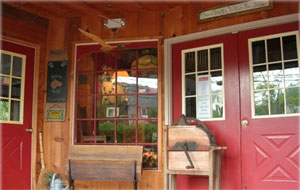 Just outside of Philadelphia, farm country rolls away to the north and west. Small historic villages like Skippack, which lies between Blue Bell and Collegeville, have provided town life for rural eastern Pennsylvania communities for over a hundred years. Skippack is still farmland; drive away from the main road in either direction and you’ll find yourself surrounded by corn and vales of pretty red cows. But, the relentless march of new housing is also in evidence, so for every working farm, old stone granary, or dilapidated barn you see from the road, you’ll also find new cul-de-sacs occupied by young families and Philadelphia commuters.
Just outside of Philadelphia, farm country rolls away to the north and west. Small historic villages like Skippack, which lies between Blue Bell and Collegeville, have provided town life for rural eastern Pennsylvania communities for over a hundred years. Skippack is still farmland; drive away from the main road in either direction and you’ll find yourself surrounded by corn and vales of pretty red cows. But, the relentless march of new housing is also in evidence, so for every working farm, old stone granary, or dilapidated barn you see from the road, you’ll also find new cul-de-sacs occupied by young families and Philadelphia commuters.
Like the best antiques destinations, Skippack is a perfect combination of the cherished old and the whimsical new. Between the antique shops (and there are plenty of them), you’ll find no lack of craft stores, shops selling garden and interior decorations, and lovely little street side cafes where those out for an autumn stroll can enjoy a cinnamon latte and rest their feet for a while.
If you drive down Skippack Pike (route 73) from Philadelphia toward Skippack you’ll find yourself passing first through the tiny village of Cedars. The distinguishing edifice in Cedars is the Cedar’s Antiques Emporium, a beautiful converted old barn (the restored barn alone is worth a look) with a crowing rooster painted on the side.
The emporium is a co-op which opened recently and is still in search of dealers. Case and booth rentals are available (call 610-584-1885 for details—no crafts) but the space appears to be filling quickly. The established dealers offer books, artwork, nautical items and furniture. One piece I had a hard time walking away from: an optometrist’s desk. It’s something like a roll-top secretary but flatter, since it’s designed not for work but to display pairs of glasses. I was charmed.
Keep driving through Cedars and you’ll reach the intersection of Skippack pike and Store Road. Here you can find a place to leave the car behind (there are plenty) and stroll. There are several worthy antiques shops here including Snyder Antiques and Remains to Be Seen, a friendly cluttered little place with odd hours. But two of these in particular are not to be missed, for different reasons.
First: Green Wolf’s Village Barn. The name is poetic, and the store is one of the most pleasant antique shops I’ve entered in years. Owned by Harry and Sylvia Wolf, the shop occupies an airy and beautifully lit barn-like space with a woodworking studio below and loft above. The barn is filled floor to ceiling with Rosebud-style sleds, farmhouse chairs, And Sylvia’s collection of antique washing machines (she calls them “gifts from loving husbands”). A back room displays furniture built from the wood of old barns and bookshelves made from the pipes from an antique pipe organ. The Cardinal Hollow Winery leases space in the building for a tasting room—you walk past the old farm supplies to get to where the wine is.
The second shop of note in Skippack is almost an institution here. It’s called Thorpe Antiques, and it’s designed less for casual strollers and more for people who are serious about antiques. If you love old things, love being left alone among old things in quiet old rooms in old buildings, and if you like ticking grandfather clocks and friendly cats—which I know I do—this is your place to browse. The store reminded me of my grandparents’ house (as good antiques shops often do). Thorpe’s specializes in clock repair, but Thorpe senior, known as the Doll Doctor, made a name for himself in doll triage and doll-sized furniture. His son clarifies the distinction between himself and his father, but also seems to know a thing or two about antique dolls and toys, which are displayed in a separate room from the furniture and clocks.
If you’re looking for specific items, come to Skippack village for country antiques, farm implements, farmhouse furniture and antique hunting supplies, like guns and decoys. Art is a notable item here as well—Currier and Ives prints, Victoriana, and nautical sketches abound. Most antiques in the village appear local to Pennsylvania and the Philadelphia area, so you may find tea tables and Windsor chairs if you’re lucky. But it’s also worth a trip to Skippack just to roam past the charming store fronts, watch the leaves turn and feel the October chill in the air.
By Erin Sweeney
for Antiques.com
Antiques in Frederick, MD
September 7th, 2010 by admin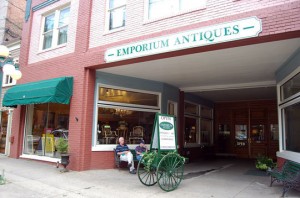
The Emporium, which is home to 130 dealers offering antiques and vintage items from all over the world.
The city of Frederick lies 49 miles northeast of Washington DC and 48 miles west of Baltimore. Founded in 1745, Frederick is considered the heart of the American Revolution, for it was here that the first act of rebellion against English taxation occurred when, on November 23, 1765, the Twelve Immortal Justices issued their declaration against the Stamp Act. It is a city that boasts George Washington and Benjamin Franklin among its earliest visitors. Today, tourists to the historic district of this second largest city in Maryland find themselves in an antique collector’s paradise.
If you’re arriving via I-70, take the East Street/Market Street exit and begin your shopping at the Old Glory Antique Marketplace on Urbana Pike just outside town. Old Glory is one of those wonderful multi dealer malls where you can find just about anything – from vintage fishing lures to sterling flatware. If you’re looking for furniture, this is the place to shop as Old Glory boasts one of the largest selections in the area.
Head north and Urbana Pike becomes Market Street and will lead you to the center of Frederick. Once you’ve reached East South Street, turn right, then left on South Carroll Street and prepare yourself as you’ve entered the zone. There are literally hundreds of antique dealers in dozens of stores within an 8 block radius of where you stand.
Cannon Hill Place Antiques should be your first stop. This oldest antique mall in Frederick can be found in a beautiful stone building that was built in 1780 by Hessian troops. After the war (Revolutionary, that is), it was converted to a grain mill and has since been known as the Old Stone Granary on Cannon Hill. The two floors are filled with offerings from over 40 dealers who specialize in “Urban American Goods at Vintage Prices”
As you continue down South Carroll Street, you’ll come to Revival Consignment Exchange. While the term “consignment shop” might conjure images of baby clothes and toaster ovens, you won’t find any here. Revival Consignment features the finest estate arts and antiques. Items that have been there longer than 60 days are marked in red and discounted by 25% – but you won’t find many of those. The prices are so good that most items sell during the first week.
Revival Consignment Exchange is housed within the grandest of Frederick’s antique malls: The Emporium, which is home to 130 dealers offering antiques and vintage items from all over the world.
To truly appreciate the Emporium, you should enter through the front door on East Patrick Street (that means exiting Revival, walking to the corner and turning left). The Emporium occupies a 55,000 square foot warehouse that was built in 1912. As you walk through the massive oak doors, the wood floors, transom windows and cavernous tin ceiling complete the feeling that you’ve stepped back in time. And you can literally lose track of time as you wander through the Emporium, which stretches behind other storefronts on Patrick and Carroll Streets.
When you do find your way back to the front desk, make sure to pick up some home made preserves along with your other treasures. The cherry butter should give you enough energy to visit the at least a few of the dozens of shops still to discover in Frederick.
The Glass Cupboard for Antiques.com
Antiquing in Buenos Aires by Bob Frassinetti
September 2nd, 2010 by admin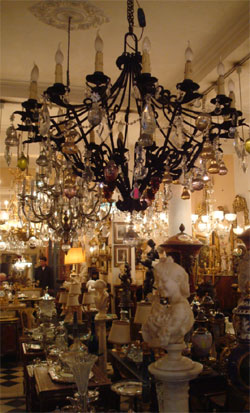 Rare and incredible objects, furniture, books, toys, artworks… all those antiques and collectibles you dream of can be found in Buenos Aires.
Rare and incredible objects, furniture, books, toys, artworks… all those antiques and collectibles you dream of can be found in Buenos Aires.
Once upon a time Buenos Aires was a very small port city with very little population surrounded by one of the world’s most fertile lands. Not too far away there were several other populations with very different traditions to the Spaniards who had populated this portside area. As the city grew and the Porteñan society evolved many Europeans chose Argentina to be their home. They immigrated with all their possessions from every corner of the old continent. This flow from Europe to Argentina first began in mid 19th century, and has never stopped till now. At the same time, as the world evolved –wars, economical possibilities, inspiration, were many of the causes that help other people chose our country as their own.
All of these new immigrants that were coming from Europe (Western and Eastern), Middle East, Asia and Africa, as well as many other Latin American countries, brought with them all kinds of objects, from paintings to mirrors and combs, from decorative items to all kinds of furniture, and so on.
This brief history of immigration in Argentina might help those that don’t know our country to understand a bit about the eclectic variety of items that can be found in this beautiful city that is Buenos Aires (specially Buenos Aires because it has always been the main gate to our great and beautiful country). Many of them were brought in immigration ships, many others were sent to these families from their homelands, some others were imported, and some other ones were the result of business among relatives who lived in their homelands and these new immigrants that were building a life in our Pampas. Those valuable family objects some times due to hard economic situations, or may be because there was no one to inherit them, have taken a path towards flea markets, auctions or antiques shops.
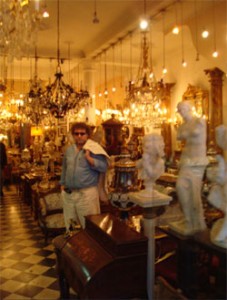 During the last few years there has been a huge turn in our economy, the peso (local currency) has lost much of its value in relation to the dollar and the Euro, this situation has impacted in many areas of our everyday life. On the dark side one of the biggest consequences of this economic shift has been an intense flow of goods towards all kinds of markets, in order to keep on with a certain lifestyle. Therefore many families have found themselves in a situation were they had to sell many of their family’s goods. On the bright side this new valuation of the peso has made of Argentina a more appealing place to visit for foreigners, since its much cheaper than many other big international metropolis though still shows all its splendor in its culture, art, fashion and good sense of living.
During the last few years there has been a huge turn in our economy, the peso (local currency) has lost much of its value in relation to the dollar and the Euro, this situation has impacted in many areas of our everyday life. On the dark side one of the biggest consequences of this economic shift has been an intense flow of goods towards all kinds of markets, in order to keep on with a certain lifestyle. Therefore many families have found themselves in a situation were they had to sell many of their family’s goods. On the bright side this new valuation of the peso has made of Argentina a more appealing place to visit for foreigners, since its much cheaper than many other big international metropolis though still shows all its splendor in its culture, art, fashion and good sense of living.
Our local flea markets, open fairs and antiques shops are open history books that show this turns in our lives.
Plus, these are excellent places to shop for those items all art lovers dream of, as well as an excellent opportunity for art dealers that wish to offer their regular clients high class items at reasonable prices.
One of the most beautiful open air markets in the city is in the historical neighborhood of San Telmo, that’s open all day during Sundays, from very early in the morning to late in the afternoon. Surrounded by countless antiques shops that open their doors to the public all week long, this fair is just beautiful, with very good quality items… Bargaining is always an interesting possibility when acquiring these type of objects, always a plus to get what you want at the price you want to.
In the outskirts of the city, the Solano fair is one outstanding market where if you have a sharp eye for antiques you can find absolutely amazing treasures. Since this fair is very much for locals you can find all from old clothes, semi used house goods, and whatever people had and needed to sell… Its always better to visit this outskirts out of the tourists path fair with a local, best if you know what you want but don’t have much time and your Spanish is not very good.
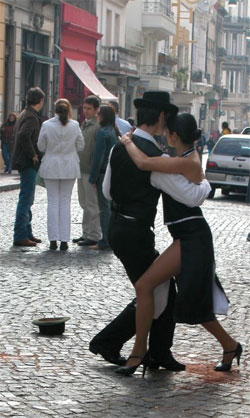 Back to the city, one excellent flea market is the Dorrego Market, in the heart of Palermo, very nearby a great restaurants area, this market has all kinds of items. Its just a matter of walking around and talking with the local people that are very kind and would gladly help you in your quest.
Back to the city, one excellent flea market is the Dorrego Market, in the heart of Palermo, very nearby a great restaurants area, this market has all kinds of items. Its just a matter of walking around and talking with the local people that are very kind and would gladly help you in your quest.
On the other end of the city, during the weekends there’s an other kind of flea market in Peru abajo. Located in the beautiful residential area of Acasusso you will find this fair has all kinds of decorative items and furniture, one of its specialties are chandeliers at very reasonable prices… High class and good prices, one excellent combo!
These are the most representative fairs and markets in BA. There’s nothing you can’t get, you name it, they have it… And of course, these are excellent sights when touring through the city of tango, ‘cause there are many different street shows that weekly chose those locations to show their art: tango, puppeteers, street theatre, live music, plus all kinds of local street food to enjoy during your walk, there’s no way that can go wrong!
Bob Fressinetti is a writer and antique enthusiast living in Buenos Aires
Antiques in Philadelphia
August 31st, 2010 by adminWith its cobblestone side streets, preserved buildings and revolutionary monuments on almost every corner, Philadelphia is certainly a historical treasure. And like any beautiful old city, Philadelphia is prime hunting ground for beautiful collections of old things, especially if one knows where to look.
If you’re antiquing in Philadelphia, head first to Chestnut Hill, just to the north of center city. Germantown Ave, marked by streetcar tracks, runs down the middle of this quiet leafy neighborhood lined with the awnings of bakeries, toy stores, and a locally famous cheese shop. This is a place where bells jingle when you push open shop doors that have clearly stood on their thresholds for generations, if not centuries.
The entire neighborhood speaks to the best of authentic high-end shabby chic—Even private homes blocks from Germantown Ave display a mesmerizing combination of age and Philadelphia grace, with elegantly peeling Victorian window frames and vine-tangled garden gates. Try to open an antiques shop here and you’d better be able to keep up with customers who know exactly what they’re looking for and can afford it when they see it.
Strolling westward from Abington Ave, stop first in Lavender Hill, owned by Florence Maloumian. Simple and lovely paintings from the rural Catskills, refinished Eastlake Victorian furniture, and the signature pieces in the store—collections of dried and silk flowers in playful color combinations– draw the eye to every corner of Lavender Hills’ artistically cluttered space.
Next stop in at Garden Gate Antiques, a multi-owner shop a few doors down. Make a note of the authentic African pieces in the back corner, including statuary from Malawi and a curious Sowei mask “for women’s initiation.” Run by a husband and wife team of passionate African art collectors, this section of the store features masks and textiles at marked down prices for the rest of the summer.
Move next to George Hoby’s shop where a wall-mounted bighorn sheep gazes out over a collection of odds and their corresponding ends arranged in layers so dense you’ll want to slow your gander so as not to miss anything. Hoby himself presides from the back of the store in a chair that I spent some time studying (not for sale apparently, though I doubt I could afford it if it was). The space is a bit too small for an extensive furniture collection, but features watercolors by Abraham Hankins, ceramics, and everything from old flutes, to girly art-deco ads, to salt and pepper shakers. Hoby’s easy style makes the room a pleasant place to linger for a while.
And finally, no antiquing day in Chestnut Hill is complete without a look into the Antiques Gallery. This shop is representative of the neighborhood in many ways, but it’s best to know your own preferences here, since there’s a lot to see and the store sometimes keeps non-standard hours.
While strolling and perusing, examine the unbelievable collection of maps and historic prints at the map store. Take a break for coffee at Cake or the bakery across from the toy store, and don’t miss the cheese shop. Years ago, the owners of this place offered me a taste of Papillion French blue cheese that changed my life. Chestnut Hill tends to make an afternoon of antiques shopping into a complete experience– Take advantage of the tendency, especially if you’re only in town for a day or two.
By Erin Sweeney
for Antiques.com

